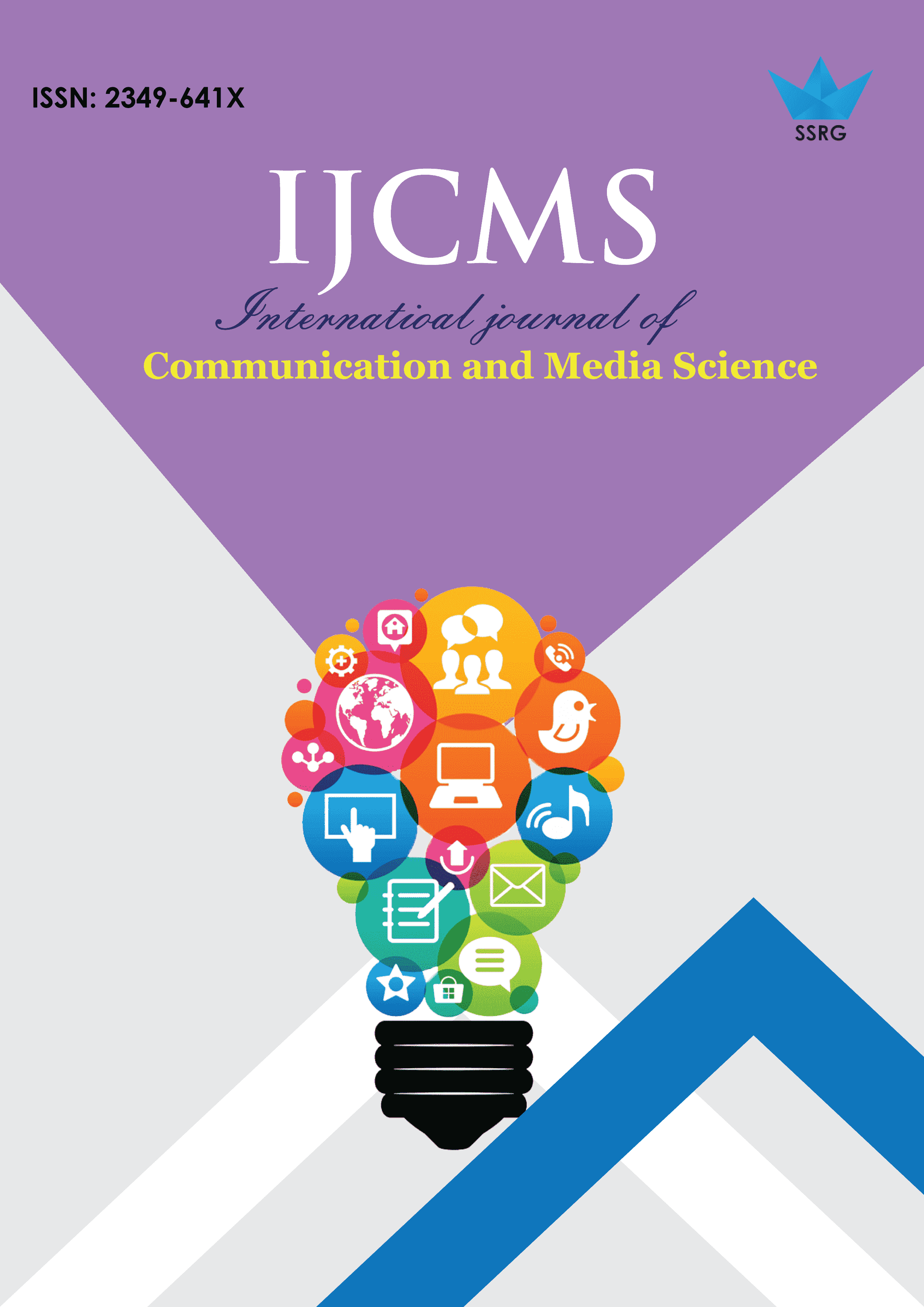South-East Residents' attitude Towards newspaper Reportage of The Campaign Against Child Abuse In Nigeria

| International Journal of Communication and Media Science |
| © 2020 by SSRG - IJCMS Journal |
| Volume 7 Issue 3 |
| Year of Publication : 2020 |
| Authors : Okolie, Uloma Rosemary Ph.D, Orji, Uchenna Franklin |
How to Cite?
Okolie, Uloma Rosemary Ph.D, Orji, Uchenna Franklin, "South-East Residents' attitude Towards newspaper Reportage of The Campaign Against Child Abuse In Nigeria," SSRG International Journal of Communication and Media Science, vol. 7, no. 3, pp. 1-9, 2020. Crossref, https://doi.org/10.14445/2349641X/IJCMS-V7I3P101
Abstract:
The study evaluated Southeast residents' attitudes towards newspaper reportage in the campaign against child abuse. The objectives of this study, among others, were to; find out the level of awareness created on issues of child abuse through exposure to newspaper reports among Southeast residents; identify the extent to which the exposure to newspaper reportage improve the knowledge of South-East newspaper readers on the fight against child abuse, and determine the influence of newspaper reports on Southeast residents' attitude towards child abuse. The study was anchored on agenda setting and social responsibility theories. The study adopted mixed-method research designs involving survey research and in-depth research methods to collect quantitative and qualitative data. A sample size of 513 respondents was drawn from a population of 21,297,016, using an Australian online calculator. A multi-stage sampling technique was used for this study. The questionnaire and interview schedule were used as instruments for data collection. The researcher purposively selected 20 journalists from the states in South-East Nigeria. The findings revealed that: Southeast residents level of awareness of child abuse stories reported in Nigerian newspapers is high at 52.8%; the extent to which exposure to newspaper reportage improved the knowledge of Southeast residents on the fight against child abuse is moderate at 38%, and exposure to newspaper reportage has influenced Southeast residents' attitude towards child abuse positively at 60.5%. It was, therefore, concluded that newspapers are vital in the fight against child abuse in Nigeria. It was, therefore, recommended as follows: the need for persistent use of newspapers to report issues of public importance like child abuse; newspapers should carry information pertaining to child abuse in their reportage; in educating, enlightening, and sensitizing the citizenry, newspapers should remain a major source in championing the course against child abuse; and people should be empowered information-wise through this medium by establishing specialized newspapers that have to do with societal crimes like child abuse.
Keywords:
Awareness, Child abuse, Newspaper, Knowledge, Reportage, Residents, South-East
References:
[1] Awosola, R.K. & Omoera, O.S. (2008). “Child rights and the media: The Nigerian Experience”. Stud Home Comm. Sci 2(2) 125-131.
[2] Babbot, M. (2018). “On the frontline: Child well-being and the role of the Zimbabwean mass media in awareness creation”. Sociology International Journal, 2(3)257-259.
[3] Baran, S. J. (2002). “Introduction to mass communication, media literacy, and Culture (2nd ed)”. New York: McGraw Hill Higher Education.
[4] Edeh, S. (2017). “Child abuse prevalent in all of Nigeria's 36 states”. Retrieved on 8/11/2017fromhttp://googleweblight.com/i?u=https://www.vanguardngr.com/2017/05/child-abuse-prevalent-nigerias-36-states-unicef/&grqid=sfVOBio&hl=en-nig
[5] Ejiofor, A.C., Ojiakor, I.C. & Nwaozor, A.O. (2017). “The role of Nigerian film in the fight against child sexual abuse. Nnadiebube” Journal of Social Sciences, 1(1) 71-80.
[6] Salami, A. G. RN, PhD, Oyundoyin, J. O. PhD, and Adetunji, H.A. PhD, MPH, FRSPH, "Caregivers Perception of Child Abuse and Neglect in Selected Schools in Lagos State, Nigeria" SSRG International Journal of Medical Science 6.2 (2019): 1-7.
[7] Hasan, S. (2014). “Mass communication: Principles and concepts (2nd Edition)”. New Delhi: CBS Publishers and Distributors OVC Limited.
[8] Kayode, O. O. & Adeniran, R. A. (2016). “Nigerian press coverage of children as victims and perpetrators of crimes.” Retrieved from www.researchgate.net/publication/289238266-Nigerian-Press- Coverage-of Children-as Victims and Perpetrators of Crimes.
[9] Ngoa, S.N. (2012). “Agenda setting: A theory in the process. In C.T. Ekeanyaynwu, S.N. Ngoa & T.A Sobowale (Eds.)” Critique and application of communication theories (1-27) Ota: Covenant University Press.
[10] Nlewem, C. & Amodu O. (2016). “Knowledge and perception of sexual abuse amongst female secondary school”.
[11] Nwaolikpe, O. N. (2015). “Print media representation of child trafficking in Nigeria”
[12] Nwokedi, O. P. (2016). “Effectiveness of broadcasting in combating child abuse in southeast Nigeria. A thesis presented to the school of postgraduate studies university of Nigeria”, Nsukka, in fulfillment of
the requirements for the award of doctor of philosophy degree in mass communication
[13] Oak Foundation (2013). “The role of media in child protection: challenges and opportunities in Uganda”. Kampala: Panos Eastern Africa.
[14] Ojiakor, C.I. Iheanacho, O.C., Nkwam-Uwaoma, A. & Dibia, N.P. (, 2019). “Coverage of child rights abuse in Nigerian newspapers”. Asian Research Journal of Arts and Social Science, 8(4), 1-9. Doi: https://doi.org/10.9734/arjass/2019/v81430109
[15] Okoye, U.O. (2011). “Knowledge and awareness of the child's rights act among residents of a University town in Enugu State, Nigeria”. International Research Journals, 2(10)1595-1601. Retrieved from http://www.interesjournals.org/Er
[16] Onyido, J. A & Vareba, G.P. (2019). “Child abuse and its implications for sustainable development in Nigeria”. International Journal for Innovation Education and Research, 7(2)45-53. DOI: https://doi.org/10.31686/ijier.Vol7.Iss2.1320.
[17] Powell, F. & Scanlon, M. (2018). “The media and child abuse”. Bristol: Policy Press
[18] Qayyum, H.(2018). “Media coverage on child sexual abuse in developing countries”. International Journal of Scientific & Engineering Research, 9(11) 1223-1229.=
[19] Queensland Government (2017). “What is child abuse?” Retrieved from https//www.communities.9/d.gov.an/childsafety/protecting-children/what-child-abuse.
[20] Saint-Jacques, M.C., & Villeneuve, P., & Turcotte, D., & Drapeau, S., & Ivers, H. (2011). “The role of media in reporting child abuse”. Journal of Social Science Research, 1-13.
[21] Usadolo, S.E. & Gwanya, T.T. (2012). “Television Violence: A reflection of the views of children in South Africa”. Journal of Communication and Media Research, 4( 2) 31-42.
[22] Welson, N. N. & Mohamed, Y. A. (2019). “Awareness of different forms of child abuse among Beni Suef University students: Descriptive survey”. Egyptian Journal of Forensic Sciences, 9(68)1-16. DOI: https://doi.org/10.1186/s41935-019-0174-y
[23] Youth Empowerment and Development Initiative (2015). “Child abuse survey”. Retrieved from www.googlesearch.com.

 10.14445/2349641X/IJCMS-V7I3P101
10.14445/2349641X/IJCMS-V7I3P101